电信计费管理系统设计与实现设计
电信综合计费系统的研究与实现
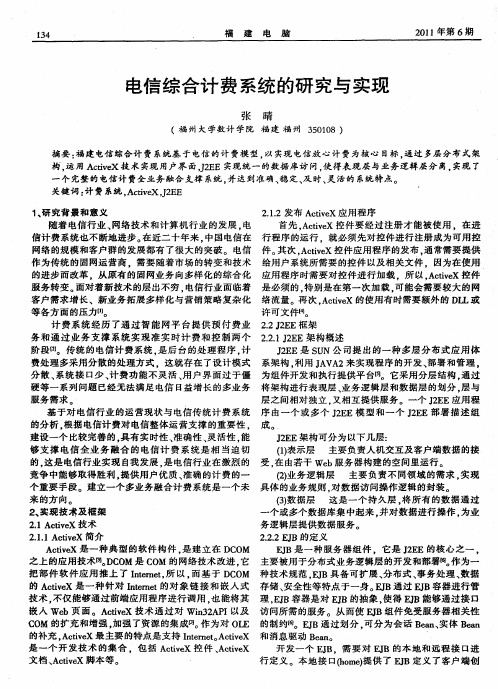
21 . 2发布 A t e . ei X应 用 程序 v 随着 电信行 业 、 网络 技 术 和计 算机 行 业 的发 展 , 电 首 先 。 c vX 控件 要 经 过 注册 才 能被 使 用 。在 进 Ate i 信 计费 系 统也 不断 地进 步 。 在近 二 十年来 , 国电信在 行 程序 的运行 .就必 须先 对 控件 进行 注册 成 为可用 控 中 网络 的规模 和 客户 群 的发展 都有 了很 大 的突破 。电信 件 。 次 。 ei X控件 应 用程 序 的发 布 。 常需 要提 供 其 A te v 通 作 为传 统 的 固网运 营商 .需 要 随着 市场 的转变 和 技术 给用 户 系统所 需要 的控 件 以及 相 关文 件 .因为在 使 用 的进 步 而 改革 .从原 有的 固网业 务 向多 样 化 的综合 化 应用 程序 时需 要对 控 件 进行 加载 ,所 以 . ci X控 件 A te v 服务 转变 。 面对 着新 技术 的层 出不 穷 . 电信 行业 面 临着 是必 须 的 , 特别 是在 第 一次 加 载 。 能会 需要 较 大的 网 可 客户 需求 增 长 、新 业 务拓 展 多样化 与 营 销策 略 复杂 化 络流 量 。再 次 。 ci X 的使用 有 时需要额 外 的 D L或 A te v L 等各 方面 的压 力【 l 1 。 许 可 文件【 4 】 。 计 费 系 统 经 历 了通 过 智 能 网 平 台提 供 预 付 费业 22J E . 2 E框 架
14 3
福
建
电脑 21 0 1源自第 6期 电信 综 合 计 费 系统 的研 究 与 实现
张 晴
(福 州 大学数 计 学院 福 建 福 州 3 0 0 5 18)
摘 要 : 建 电信 综合 计 费 系统基 于 电信 的计 费模 型 , 实现 电信 放 心计 费为核 心 目标 , 福 以 通过 多层 分 布 式架 树 , 用 A d e 技 术 实现 用户界 面 , E 实现 统 一 的数据 库访 问 , 运 c vX J E 2 使得 表 现 层与 业务 逻辑 层分 离 , 实现 了 个 完整 的 电信 计 费全 业务 融合 支撑 系统 , 达到 准确 、 定 、 时、 活 的 系统 特 点。 并 稳 及 灵 关键 词 : 费 系统 , t e J E 计 Ac vX, E i 2 ’
计费系统方案

计费系统方案计费系统方案引言计费系统是一种用于计算和记录用户消费的系统,广泛应用于各种服务行业,如电信、互联网、能源等。
一个稳定、高效的计费系统能够帮助企业准确计算用户消费金额,提供统计报表以及支持多种计费模式。
本文将介绍一个基于云计算技术的计费系统的方案。
1. 系统架构计费系统的架构需要满足高可用性、可伸缩性、安全性等要求。
一个典型的计费系统架构包含以下组件:- 用户管理:负责用户的注册、登录、权限管理等功能。
- 订单管理:负责管理用户的消费订单,包括创建、修改、删除等操作。
- 计费引擎:核心组件,负责计算用户的消费金额,支持多种计费模式,如按时间、按流量、按次数等。
- 财务管理:负责记录用户的消费金额和支付状态,提供报表和对账功能。
- 通知服务:负责发送计费通知给用户,如账单通知、余额不足通知等。
- 数据存储:用于存储用户信息、订单信息、计费规则等数据。
- 监控与告警:负责监控系统运行状态,并在发生异常时发送告警通知。
2. 技术选择在设计计费系统时,需要考虑系统的性能、可靠性和可扩展性。
常用的技术选择包括:- 数据存储:可以选择传统的关系型数据库(如MySQL)或者NoSQL数据库(如MongoDB、Redis)来存储用户信息、订单信息等数据。
- 计算引擎:可以选择使用编程语言(如Java、Python)来实现计费逻辑,也可以选择使用规则引擎(如Drools)来实现计费规则。
- 消息队列:可以选择使用消息队列(如Kafka、RabbitMQ)来实现订单异步处理和通知服务。
- 分布式存储:可以选择使用分布式文件系统(如Hadoop HDFS)来存储大量的订单数据和日志数据。
- 监控与告警:可以选择使用监控工具(如Prometheus、Grafana)来监控系统的运行状态,并及时发送告警通知。
3. 系统流程一个典型的计费系统的流程如下:1. 用户注册:用户通过注册功能进行注册,系统会保存用户的基本信息,如用户名、密码等。
江苏电信iptv业务管理系统设计与实现

第五章系统实现方案业务层需要完成的功能是各种业务规则和逻辑的实现。
业务层中的代码,用于解决或满足特定业务领域的问题逻辑。
这是整个应用系统中最为复杂的部分.这一层对应于图3--5中的应用服务器层.而且由于我们IPTV业务管理系统分为多个功能模块,所以这一层的应用服务器也是分成多个服务器进程分布在多台服务器上的。
图5一lIPI"V用户开户图5_2request和response的类图在业务层中,我们把每~个具体的业务封装在一个co.and类中。
Command类簇的类图如图5—3所示.其中基类是一个纯虚类。
是一个抽象的接口.NfAdminComand类是NfO:mmnd类的子类.该子类实现了三个重要的类的操作:action):往日志文件里写操作publicvoidrriteLog(StringadminName,intdomainId,String记录:第五章系统实现方案提供查询与统计功能。
5.4.1系统模块功能简介系统由较多的功能模块组成,这里以用户管理和内容管理为例介绍系统功能的实现:(1)用户管理模块用户管理模块包括用户开户与设置、用户信息查询、用户账户管理、用户分组管理、集团用户管理、CP/SP注册、cP/sP查询、业务运营商管理、权限管理等子模块。
该模块主要功能是提供用户、cP/sP、操作曼信息录入数据库的界面,提供用户信息的查询修改界面。
此外,对于操作员还设置了权限管理子模块1)用户开户与设置该模块主要负责用户信息的录入与帐号信息设置,开户信息分为账号信息项、业务信息项和基本信息项。
帐号信息项包括用户开在哪个业务运营商下,所属业务区、用户号段、数字帐号、用户登录名、用户账户类型、密码、用户类型、付费类型,关联宽带帐号、信用度。
其中数字帐号可按要求填入也可由系统自动生成,需保证数字帐号的唯一性。
IPTV业务信息项包括童锁密码、pop节点名称、终端类型、机项盒序列号、软终端(PSl00)序列号、机顶盒模板、软终端模板、所属用户分组、开机频道、归属EP6服务器组。
电信计费管理系统VB课程设计
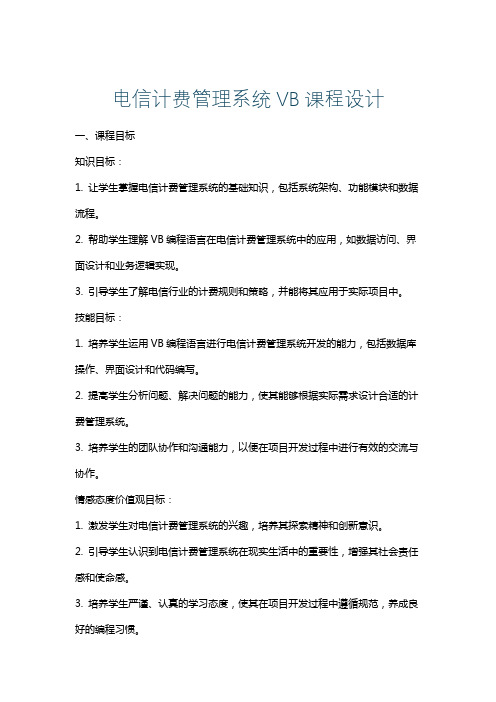
电信计费管理系统VB课程设计一、课程目标知识目标:1. 让学生掌握电信计费管理系统的基础知识,包括系统架构、功能模块和数据流程。
2. 帮助学生理解VB编程语言在电信计费管理系统中的应用,如数据访问、界面设计和业务逻辑实现。
3. 引导学生了解电信行业的计费规则和策略,并能将其应用于实际项目中。
技能目标:1. 培养学生运用VB编程语言进行电信计费管理系统开发的能力,包括数据库操作、界面设计和代码编写。
2. 提高学生分析问题、解决问题的能力,使其能够根据实际需求设计合适的计费管理系统。
3. 培养学生的团队协作和沟通能力,以便在项目开发过程中进行有效的交流与协作。
情感态度价值观目标:1. 激发学生对电信计费管理系统的兴趣,培养其探索精神和创新意识。
2. 引导学生认识到电信计费管理系统在现实生活中的重要性,增强其社会责任感和使命感。
3. 培养学生严谨、认真的学习态度,使其在项目开发过程中遵循规范,养成良好的编程习惯。
本课程针对高年级学生,结合学科特点和教学要求,旨在提高学生的实践能力、创新意识和团队协作精神。
通过本课程的学习,使学生能够将所学知识应用于实际项目中,为将来从事电信行业相关工作打下坚实基础。
同时,注重培养学生的情感态度价值观,使其成为具有责任感和使命感的新时代青年。
二、教学内容1. 电信计费管理系统概述:介绍电信计费管理系统的基本概念、发展历程、功能模块和行业应用。
相关教材章节:第一章 电信计费管理系统概述2. VB编程基础:回顾VB编程语言的基本语法、数据类型、控制结构、过程和函数。
相关教材章节:第二章 VB编程基础3. 数据库操作:讲解数据库的基本概念,重点学习Access数据库的操作,包括表的创建、查询和SQL语句。
相关教材章节:第三章 数据库操作4. 界面设计:介绍VB界面设计方法,学习如何制作友好、易用的操作界面。
相关教材章节:第四章 界面设计5. 电信计费管理模块设计:分析电信计费管理模块的需求,学习如何利用VB 实现计费策略和数据处理。
中国电信在线计费系统(OCS)总体技术方案V0.8
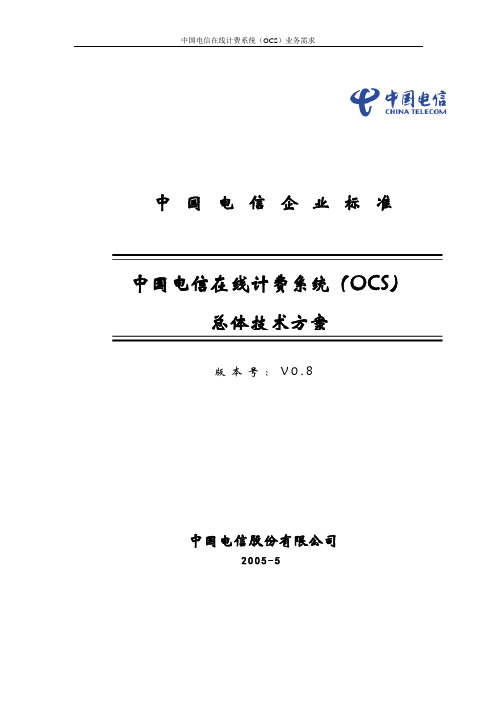
项目负责人:李连祥、刘晓亮
项目组:董斌(组长)、周峰、李洁,张峰,高国文,解彦良,石松奇,梁林志,王巍,戴志强、黄怡婷、曾旸、王晓强、綦群、魏科学、陈松、Cynthia Leung等。
在项目组工作期间,得到了中国电信股份有限公司业务支撑中心张国珍总监、李连祥资深专家及上海研发中心移动通信部秦达主任等领导的大力支持和亲自指导,并对文档提出了许多宝贵的建议和意见。另外,在文档编制过程中,得到了华为、西门子、HP、联创、天源迪克等公司的积极协助,在此一并表示感谢!
定价策略(Tariff):一套定义利用电信网络使用承载/会话/服务电信服务的价格参数。
DCC Proxy:Diameter Credit ControlProxy。DCC协议路由Proxy,负责Diameter协议的转发。
[11]3GPP TS 32.297: "Telecommunication management; Charging management; Charging Data Records (CDR) file format and transfer".
[12]3GPP TS 32.298: "Telecommunication management; Charging management; Charging Data Record (CDR) parameter description".
综合业务管理平台(ISMP):主要负责数据增值业务的用户管理、SP/CP管理、内容管理、产品管理、定价管理、鉴权/计费、定购关系管理、终端管理、统一配置管理、用户门户、SP门户、统计分析等功能的综合管理平台。
业务控制点(SCP):负责存储与执行用户数据和业务逻辑的功能实体,它的主要功能是接收SSP送来的查询信息并查询数据库,并能根据SSP上报来的呼叫事件启动不同的业务逻辑,向相应SSP发出呼叫控制指令。
南邮 简易电信计费模拟系统 程序设计报告
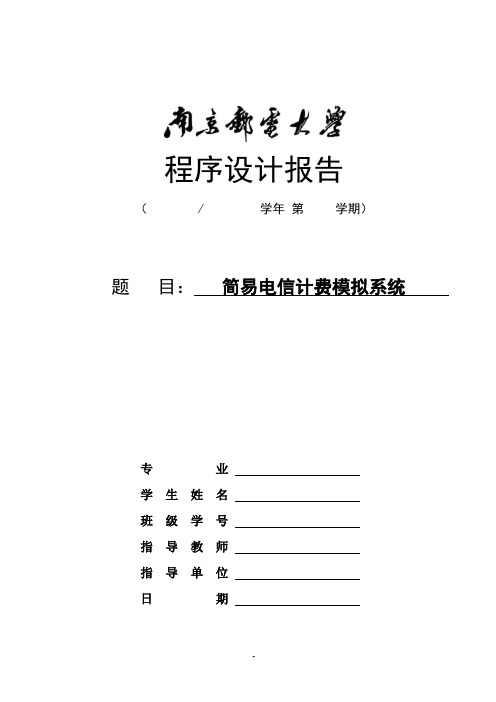
程序设计报告( / 学年第学期)题目:简易电信计费模拟系统专业学生姓名班级学号指导教师指导单位日期一.课题内容和要求我的程序用C语言编程。
可以完成模拟电信计费管理的简易信息系统的功能。
具体功能如下:1.用户管理。
用户信息初始化存储在数组结构中,管理员登录后可对用户进行增加、删除、修改和查询。
2.计费功能。
根据存放在第二个结构数组中的各用户通话记录,对每一条通话记录计算其通话费用,并将结果保存在第三个结构数组中。
其中通话费的计算方法如下:长途电话费=费率(元/分钟)×通话时长(分钟)本地电话费为:3分钟以内0.2元,以后每1分钟递增0.1元。
注:在我的程序中,方便起见,规定费率统一为2元/分钟。
3.话费查询。
输入一个电话号码和密码,将用户输入的密码与该用户信息中初始化的密码进行匹配,密码正确方可从统计该电话号码的所有本地话费、长途话费,并查找其用户名,最后在屏幕上显示:用户名电话号码本地话费长途话费话费总计4.话单查询。
输入一个电话号码和密码,将用户输入的密码与该用户信息中初始化的密码进行匹配,密码正确方可显示该用户的所有通话记录。
输出格式为:用户名主叫电话号码被叫电话号码通话时长二、需求分析随着社会的发展,通信行业越来越普遍,越来越发达。
电信管理系统显得尤为重要,因此我做一个简单的电信计费模拟系统来模拟一下电信管理系统的模式。
该系统需要预先将用户信息和通话记录输入结构数组中。
在管理员页面,需要正确输入管理员的姓名与密码。
(在该程序中,我设定管理员姓名为jack,密码为111111)在用户功能页面,需要正确输入电话号码,若信息库中没有该号码则无法查询。
然后输入密码,与该用户的密码匹配才能查询话费和话单。
三、概要设计在此只给出求通话记录费用的小段程序代码。
for(x=0;x<w;x++) //求ccc[]的值{strcpy(&ccc[x].number,&bbb[x].zhujiao);switch(bbb[x].type){case 1:{if(bbb[x].time<=3)ccc[x].bendi=0.2;elseccc[x].bendi= (bbb[x].time-3)*0.1+0.2;};break;case 2:{ccc[x].changtu=bbb[x].time*2.0; //设长途费率2元/分};break;}ccc[x].sum=ccc[x].bendi+ccc[x].changtu;}程序框图如下:四、源程序代码#include<stdio.h>#include<stdlib.h>#include<string.h>int denglu();int caidan1(); //管理员菜单int caidan2(); //用户菜单int add(); //管理员菜单中的添加用户功能函数int delet(); //管理员菜单中的删除用户功能函数int change(); //管理员菜单中的修改用户功能函数int search(); //管理员菜单中的查询用户功能函数int chahuafei(); //用户菜单中的查话费功能函数int chahuadan(); //用户菜单中的查话单功能函数int i; // 用于确定是哪个用户int q; // 用于确定是管理员还是用户int n=0; //用于管理员和用户返回登录页面int ww=0; //用于管理员返回管理员菜单int gg=0; //用于用户返回用户菜单int k=2; //用户信息有两条int w=6; //通话记录有条double ben[10]; //用于统计各用户本地话费double chang[10]; //用于统计各用户长途话费double sum[10]; //用于统计各用户总话费char namex[10];char passwordx[7];char numberx[8];struct gerenxinxi //用户信息{char name[10];char password[7];char number[8];double bendi;double changtu;double sum;};struct tonghuajilu // 通话记录{char name[10];char zhujiao[8];char beijiao[8];double time;int type; // 1表示本地,表示长途};struct feiyong //每条通话记录的费用{char number[8];double bendi;double changtu;double sum;};struct gerenxinxi aaa[10]={ //初始化两个用户的个人信息{"mike","000000","1234560"},{"james","000001","1234561"}};char gname[10]= "jack";char gpassword[7]= "111111" ; //初始化管理员的信息struct tonghuajilu bbb[10]={{"mike","1234560","1000000",100.0,1},{"james" ,"1234561","1000001",12.0,1}, //初始化前条通话记录{"james" ,"1234561","1000001",12.0,1},{"mike" ,"1234560","1000001",100.0,1},{"mike","1234560","1000002",30.0,2},{"james","1234561","1000003",14.0,2}};struct feiyong ccc[10];int main(){int x,t,y;for(x=0;x<w;x++) //求ccc[]的值{strcpy(&ccc[x].number,&bbb[x].zhujiao);switch(bbb[x].type){case 1:{if(bbb[x].time<=3)ccc[x].bendi=0.2;elseccc[x].bendi= (bbb[x].time-3)*0.1+0.2;};break;case 2:{ccc[x].changtu=bbb[x].time*2.0; //设长途费率元/分};break;}ccc[x].sum=ccc[x].bendi+ccc[x].changtu;}for(t=0;t<k;t++) //求各用户的各费用{for(y=0;y<w;y++){if(strcmp(aaa[t].number,ccc[y].number)==0){ben[t]=ben[t]+ccc[y].bendi;chang[t]=chang[t]+ccc[y].changtu;sum[t]=ben[t]+chang[t];}}}do{n=0;denglu(); //登录函数,n用于返回登录页面}while(n);}int denglu(){int a=1;int b=1;int m=1;int l=1;system("cls");printf("=========欢迎登录=========\n");printf("请选择身份登录:______管理员;______普通用户\n");printf("请输入:");scanf("%d",&q);while(l){if(q!=1&&q!=2){printf("error!\n");printf("请输入:");scanf("%d",&q);}elsel=0;}if(q==1){printf("请输入管理员您的名字: ");scanf("%s",namex);while(a){if (strcmp(namex,gname)!=0){printf("error!\n");printf("请输入管理员您的名字: ");scanf("%s",namex);}elsea=0;}printf("请输入密码: ");scanf("%s",passwordx);while(b){if (strcmp(passwordx,gpassword)!=0){printf("error!\n");printf("请输入密码: ");scanf("%s",passwordx);}elseb=0;}printf("恭喜管理员登录成功!\n");do{ww=0;caidan1();}while(ww);}else if(q==2){do{gg=0;caidan2(); //进入用户菜单}while(gg);}}int caidan1() //管理员菜单{int z,qq;int y=1;system("cls");printf("============您好** 管理员============\n");printf("1----增加用户\n");printf("2----删除用户\n");printf("3----修改用户\n");printf("4----查询用户\n");printf("0----返回登陆页面\n");printf("请输入: ");scanf("%d",&z);while(y){if(z!=0&&z!=1&&z!=2&&z!=3&&z!=4){printf("error!\n");printf("请输入: ");scanf("%d",&z);}elsey=0;}switch(z){case 1:{add();printf("按返回管理员菜单:");scanf("%d",&qq);if(qq==1)ww=1;};break;case 2:{delet();printf("按返回管理员菜单:");scanf("%d",&qq);if(qq==2)ww=1;};break;case 3:{change();printf("按返回管理员菜单:");scanf("%d",&qq);if(qq==3)ww=1;};break;case 4:{search();printf("按返回管理员菜单:");scanf("%d",&qq);if(qq==4)ww=1;};break;case 0: n=1 ;break;}}int caidan2() //用户菜单{int p;system("cls");printf("=================欢迎尊敬的用户!===============\n");printf("1----查询费用\n");printf("2----查询话单\n");printf("0----返回登陆页面\n");printf("请选择: ");scanf("%d",&p);while(c){if(p!=0&&p!=1&&p!=2){printf("error!\n");printf("请选择: ");scanf("%d",&p);}elsec=0;}if(p==1)chahuafei();else if(p==2)chahuadan();else if(p==0)n=1;}int add() //管理员菜单中的添加用户功能函数{printf("=========请输入用户信息============\n");printf("请输入用户姓名: ");scanf("%s",&aaa[k].name);printf("\n请输入用户密码: ");scanf("%s",&aaa[k].password);printf("\n请输入用户电话号码: ");scanf("%s",&aaa[k].number);printf("添加成功!");k++;}int delet() //管理员菜单中的删除用户功能函数{char deletnumber[8];printf("========删除用户信息========\n");printf("请输入要删除用户的电话号码: \n");scanf("%s",deletnumber);for(h=0;h<k;h++){if(strcmp(deletnumber,aaa[h].number)==0)break;}for(g=h;g<k-1;g++){aaa[g]=aaa[g+1];}k--;printf("删除成功!");}int change() //管理员菜单中的修改用户功能函数{char changenumber[8];int h;printf("========修改用户信息========\n");printf("请输入要修改用户的电话号码: ");scanf("%s",changenumber);for(h=0;h<k;h++){if(strcmp(changenumber,aaa[h].number)==0)break;}printf("请输入修改后密码:");scanf("%s",aaa[h].password);printf("修改成功!");}int search() //管理员菜单中的查询用户功能函数{char searchnumber[8];int h;printf("========查询用户信息========\n");printf("请输入要查询用户的电话号码: ");scanf("%s",searchnumber);for(h=0;h<k;h++){if(strcmp(searchnumber,aaa[h].number)==0)break;}if(h!=k){printf("用户名电话号码 \n");printf("%s\t%s\n",aaa[h].name,aaa[h].number);}elseprintf("不存在该用户!\n");}int chahuafei() //用户菜单中的查话费功能函数{int o,v;int d=1;int e=1;int i=1000;printf("请输入电话号码: ");scanf("%s",numberx);while(d){for(o=0;o<k;o++){if (strcmp(numberx,aaa[o].number)==0)i=o;}if(i==1000){printf("error!\n");printf("请输入电话号码: ");scanf("%s",numberx);}elsed=0;}printf("请输入密码: ");scanf("%s",passwordx);while(e){if (strcmp(passwordx,aaa[i].password)!=0){printf("error!\n");printf("请输入密码: ");scanf("%s",passwordx);}elsee=0;}printf("用户名电话号码本地话费长途话费话费总计\n " );printf("%s\t\t%s\t\t%.1f\t\t%.1f\t\t%.1f",aaa[i].name,aaa[i].number,ben[i],chang[i],s um[i]);printf("\n按返回用户页面:");scanf("%d",&v);if(v==1)gg=1;}int chahuadan() //用户菜单中的查话单功能函数{int o,r,xx;int d=1;int e=1;int i=1000;printf("请输入电话号码: ");scanf("%s",numberx);while(d){for(o=0;o<k;o++){if (strcmp(numberx,aaa[o].number)==0)i=o;}if(i==1000){printf("error!\n");printf("请输入电话号码: ");scanf("%s",numberx);}elsed=0;}printf("请输入密码: ");scanf("%s",passwordx);while(e){if (strcmp(passwordx,aaa[i].password)!=0){printf("error!\n");printf("请输入密码: ");scanf("%s",passwordx);}elsee=0;}printf("用户名主叫电话号码被叫电话号码通话时长\n");for(xx=0;xx<w;xx++){if(strcmp(aaa[i].number,bbb[xx].zhujiao)==0)printf("%s\t\t%s\t\t\t%s\t\t\t%.1f\n",bbb[xx].name,bbb[xx].zhujiao,bbb[xx].beijiao,bb b[xx].time);}printf("\n按返回用户页面:");scanf("%d",&r);if(r==1)gg=1;}五、测试数据及其结果分析进入登录页面。
电信计费稽核管理系统设计说明书

电信计费稽核管理系统设计说明书电信计费稽核管理系统设计说明书一、背景和目标随着电信业务的不断发展和扩大,传统的计费和稽核方式已经难以满足现代电信业务的需求。
因此,我们设计了一套全新的电信计费稽核管理系统,旨在提高电信计费和稽核的效率和准确性,降低运营成本,并为电信业务提供更优质的服务。
二、系统架构本系统采用分层设计思想,将系统划分为数据层、逻辑层和表示层三层。
数据层负责数据的存储和管理,包括用户数据、计费数据、稽核数据等。
数据层采用了关系型数据库,确保数据的完整性和一致性。
逻辑层负责实现系统的业务逻辑,包括计费算法、稽核规则等。
逻辑层采用了面向对象的设计方法,将业务逻辑封装为一系列的类和对象。
表示层负责与用户的交互,包括用户登录、计费查询、稽核审批等。
表示层采用了Web应用程序的开发框架,提供了友好的用户界面和交互体验。
三、主要功能模块1、计费模块:根据用户使用的电信业务和计费标准计算费用,并生成计费报表。
2、稽核模块:对计费数据进行稽核,发现异常数据并进行处理。
3、报表模块:生成各种计费和稽核报表,包括日报、月报、年报等。
4、用户管理模块:管理用户账号和权限,确保系统安全。
5、系统管理模块:管理系统的配置和参数,维护系统正常运行。
四、系统特点1、灵活的计费算法:支持按时间、按流量等多种计费方式,并可根据业务需求进行自定义计费规则。
2、严格的稽核流程:对异常数据进行多重校验和审核,确保数据的准确性和完整性。
3、友好的用户界面:采用流行的Web设计风格,提供简洁、直观、易用的用户界面。
4、强大的安全性:采用多重身份验证、数据加密等安全措施,确保系统和数据的安全性。
5、可扩展性:采用模块化设计,方便进行系统扩展和升级。
五、总结本电信计费稽核管理系统能够有效提高计费和稽核的效率和准确性,降低运营成本,并为电信业务提供更优质的服务。
系统采用分层设计思想,将系统划分为数据层、逻辑层和表示层三层,实现了良好的解耦和可维护性。
福建电信综合计费系统的特点及关键设计
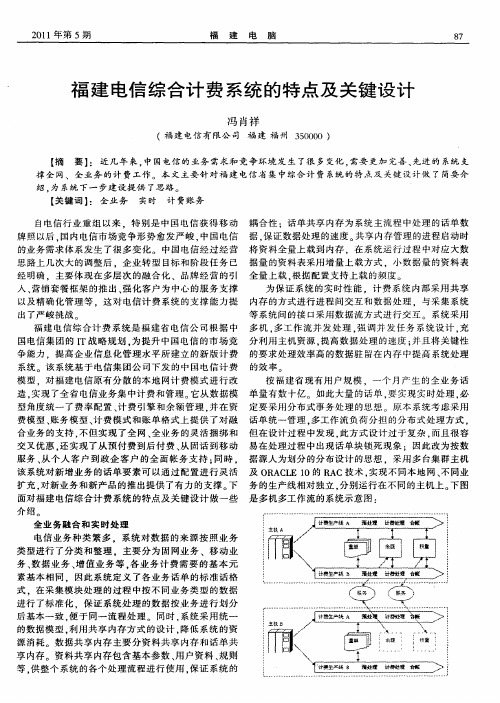
内存 中的数 据 . 引入 分 布式设 计 的思 想 . 采用 面向服务 非业务 相关公用库 和业务相 关公用 库 .其 中非业务相 的设计对公 用资源 进行更 新 和使用 。每 台主机 可处理 关 公用 库 主要包 含 基本类 、 网络类 、 配置文件 类 、 调度
21 0 1年第 5期
福 建 电
脑
8 7
福 建 电信 综 合计 费 系 的特 点及 关键 设 计 统
冯 肖祥
(福建 电信 有限公 司 福 建 福 州 3 0 0 5 0 0)
【 摘 要 】 近 几年 来 , 国电信 的 业务 需求和 竞 争环境 发 生 了很 多变化 , : 中 需要 更加 完善 、 先进 的 系统 支
出 了严 峻 挑 战
以及精 确化 管理 等 .这对 电信 计 费系统 的支撑 能力 提 内存 的方 式进行 进程 间交 互和 数据 处理 .与采集 系统 等系 统 间的接 口采用 数据 流方 式进行 交 互 系统采 用 福 建 电信综 合 计 费系 统 是福 建务 系 统设 计 , 多 强 充
国电信集 团 的 I 略规 划 . 提升 中 国电信 的市 场 竞 分利 用 主机资 源 . T战 为 提高 数据 处理 的速 度 ; 并且将 关键 性 争 能力 .提 高企业 信 息化 管理 水平 所建 立 的新 版计 费 的要 求处理 效率 高 的数据驻 留在 内存 中提高 系统处 理 系统 该 系统基 于 电信集 团公 司下 发 的 中国 电信计 费 的效 率 。 模 型 .对福 建 电信原 有分 散 的本地 网计 费模 式 进行 改 按 福 建省现 有 用户 规模 .一个 月产 生 的全业 务 话 造. 实现 了全 省 电信业 务集 中计 费和 管理 。 它从数 据模 单量 有数 十亿 。如此 大量 的话 单 , 实现 实 时处理 , 要 必
上海电信计费催欠管理系统的设计与解析
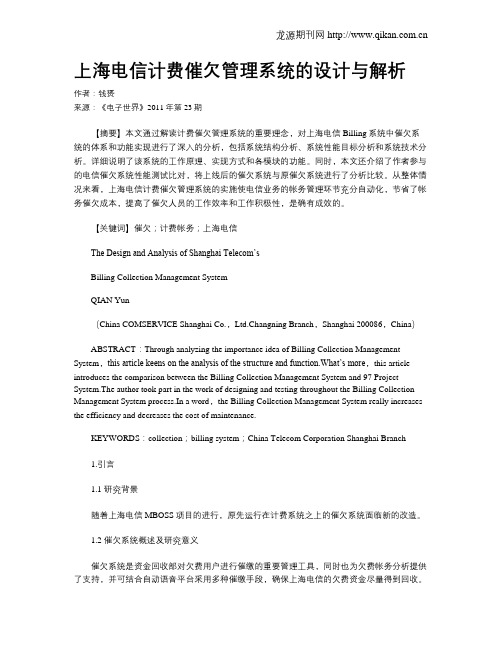
上海电信计费催欠管理系统的设计与解析作者:钱赟来源:《电子世界》2011年第23期【摘要】本文通过解读计费催欠管理系统的重要理念,对上海电信Billing系统中催欠系统的体系和功能实现进行了深入的分析,包括系统结构分析、系统性能目标分析和系统技术分析。
详细说明了该系统的工作原理、实现方式和各模块的功能。
同时,本文还介绍了作者参与的电信催欠系统性能测试比对,将上线后的催欠系统与原催欠系统进行了分析比较。
从整体情况来看,上海电信计费催欠管理系统的实施使电信业务的帐务管理环节充分自动化,节省了帐务催欠成本,提高了催欠人员的工作效率和工作积极性,是确有成效的。
【关键词】催欠;计费帐务;上海电信The Design and Analysis of Shanghai Telecom’sBilling Collection Management SystemQIAN Yun(China COMSERVICE Shanghai Co.,Ltd.Changning Branch,Shanghai 200086,China)ABSTRACT:Through analyzing the importance idea of Billing Collection Management System,this article keens on the analysis of the structure and function.What’s more,this article introduces the comparison between the Billing Collection Management System and 97 Project System.The author took part in the work of designing and testing throughout the Billing Collection Management System process.In a word,the Billing Collection Management System really increases the efficiency and decreases the cost of maintenance.KEYWORDS:collection;billing system;China Telecom Corporation Shanghai Branch1.引言1.1 研究背景随着上海电信MBOSS项目的进行,原先运行在计费系统之上的催欠系统面临新的改造。
上海电信计费催欠管理系统的设计与解析
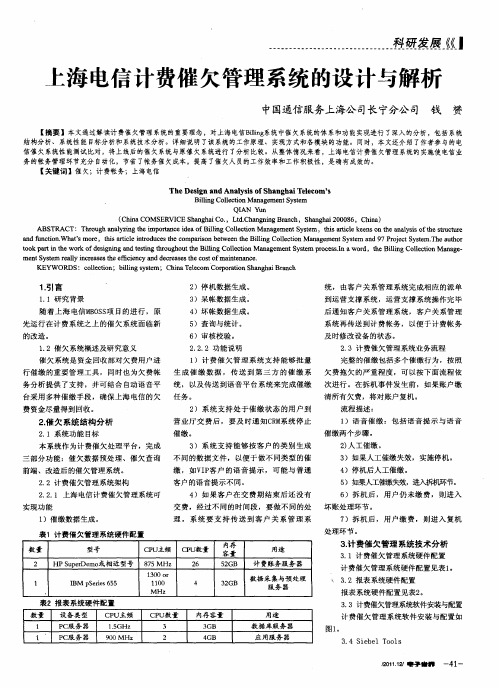
4 2 2 3改造 后 .. .
1 )在 计 费催 欠 管 理 系 统 中针 对 不 同 类 型的 欠费用 户设 定不 同催 欠场 景 ; 2 )每个催欠场景 设定对应 催缴 事件; 3 )对 催缴 事件进 行排 程 。
4 2 2 4改 造成 效 .. .
缩短建设周期的角度,
实现 功能
3 )系 统 支持 能够 按 客 户 的类 别 生 成
三 部 分功 能 :催 欠 数据 预 处理 、催 欠 查询 不 同 的数据 文 件 , 以便 于做 不 同类 型 的催 缴 ,如 V P 户 的语 音 提 示 , 可 能与 普 通 I客 客 户的语 音提 示不 同。 4 )如 果 客户 在 交 费 期 结 束后 还 没 有
L …
…
…
…
…
…
…
…
…
…
…
…
…
…
…
…
…
_
J
不是 一 一 对应 ,因 此
图 1计费催 欠 管理 系统软 件安 装与配 置 上 海 电信 计费 催欠 管理 系统 是基 于 开 催欠 多次 ;
发工具 。S ee o l是 一个基 于W n o s ib ]T o s id w 的
容 易发 生 一个 账 户 被 将 把上 海 电信 计 费催 欠 管理 系统 与 其他 电
尽可能 氐 成本;
c 窖 慷 c n 蕾 20C ut e t . 窖户
5 )作为 目 标系统
的前 瞻 性 需求 ,需 要 考 虑 与信 用度 管理 和
A 懈 出 e dCO l t 。 暑 3 l ec i n 。5
方便催 欠 员工 正确执 行催 缴操 作 。
4 2 3信用 度 系统 ..
电信运营计费管理系统论文

电信运营计费管理系统论文引言随着电信业务的快速发展和用户数量的迅猛增长,电信运营商面临着越来越复杂的计费管理问题。
传统的计费管理方式已经无法满足运营商对于计费业务的需求,因此开发一套高效且可靠的电信运营计费管理系统是迫切需要的。
本文将介绍一种基于现有技术的电信运营计费管理系统的设计和实现。
问题背景传统的电信运营商计费管理系统往往存在以下问题:1.响应时间缓慢:传统的计费管理系统通常是基于关系型数据库设计的,而在面对海量的用户数据和交易记录时,查询和计算速度往往较慢,导致用户的计费和结算等操作耗时较长。
2.数据准确性难以保证:计费管理涉及到庞大的数据量,往往需要多个系统的数据交互和计算,而这些系统之间的数据一致性难以保证,导致计费结果的准确性难以保证。
3.扩展性差:传统的计费管理系统往往是单一的、与其他系统紧密耦合的,并且难以扩展和升级。
运营商在业务发展和技术升级过程中难以适应新的计费需求和变化。
解决方案为了解决传统计费管理系统存在的问题,我们提出了一种基于现有技术的电信运营计费管理系统。
该系统的特点包括:1.采用分布式计算架构:为了提高响应速度,我们采用了分布式计算架构,将计费任务分发到多个计算节点上并行处理,大大提高了计费速度和吞吐量。
2.引入数据一致性机制:为了保证数据准确性,我们引入了事务机制和数据同步机制,确保不同节点之间数据的一致性。
同时,我们还引入了数据仓库和数据备份机制,以备份关键数据并用于后续分析和查询。
3.可扩展设计:我们采用了松耦合的架构设计,将计费系统与其他系统解耦,使得系统的各个模块可以独立扩展和升级,提高了系统的灵活性和可扩展性。
4.引入自动化运维技术:为了保证系统的稳定性和可靠性,我们引入了自动化运维技术,实现了自动化的监控、故障恢复和数据备份等功能,减少了运维人员的工作量。
系统架构电信运营计费管理系统的具体架构如下:1.前端界面:用户通过前端界面与系统交互,包括查询账单、缴费、申请退费等操作。
电信计费管理系统VB课程设计

电信计费管理系统VB课程设计一、教学目标本节课的教学目标是使学生掌握电信计费管理系统VB的基本设计和实现方法。
知识目标要求学生了解电信计费系统的业务需求、设计原则和实现技术;技能目标要求学生能够运用VB编程语言实现简单的电信计费功能;情感态度价值观目标则是培养学生的团队合作意识和问题解决能力。
二、教学内容本节课的教学内容主要包括电信计费管理系统的需求分析、系统设计和实现。
首先,学生将学习电信计费系统的业务需求,包括计费规则、用户信息管理等。
接着,学生将了解系统设计的原则和方法,如模块化设计、数据结构选择等。
最后,学生将学习如何使用VB编程语言实现电信计费功能,包括用户登录、话费查询、充值等。
三、教学方法为了达到本节课的教学目标,将采用多种教学方法。
首先,通过讲授法向学生传授电信计费系统的业务知识和设计原则。
其次,通过案例分析法让学生了解实际的电信计费系统设计和实现案例。
此外,还将学生进行小组讨论和实验,以培养学生的实际操作能力和问题解决能力。
四、教学资源为了支持本节课的教学内容和教学方法的实施,将准备以下教学资源:教材《电信计费管理系统VB编程与应用》、参考书《VB编程入门与应用》、多媒体资料《电信计费系统设计实例》以及实验设备如计算机、网络等。
这些资源将帮助学生更好地学习电信计费管理系统的相关知识和技能。
五、教学评估本节课的教学评估将采用多元化方式,全面客观地评价学生的学习成果。
评估方式包括平时表现、作业和考试等。
平时表现主要评估学生在课堂上的参与程度、提问回答等;作业主要评估学生的编程实践能力;考试则评估学生对电信计费管理系统VB知识的理解和应用能力。
评估标准将根据教学目标制定,确保评估结果的客观性和公正性。
六、教学安排本节课的教学安排将分为两个阶段:第一阶段为理论教学,第二阶段为实践教学。
理论教学阶段,安排每周两次课,每次课2小时,共计4周;实践教学阶段,安排每周一次课,每次课2小时,共计4周。
电信运营-计费管理系统

04
03
05
02
管理员管理系统
2ห้องสมุดไป่ตู้
3
4
用户管理系统
用户管理系统
帐单查询系统
具有帐单查询权限的管理员可以利用此子系统对所有用户的月账单进行查询。此子系统不仅提供对某个帐务帐号上产生的总的费用进行查询,还提供对某个帐务帐号上的每个业务帐号上产生的费用明细进行查询。具体操作如下: 1.月账单查询 具有账单查询角色的管理员进入本系统,登录成功后,可以执行如下查询操作: 根据输入的月份查询所有用户这个月的费用信息(提供分页显示)。 根据输入的月份和其它组合条件查询符合条件的用户这个月的费用信息(提供分页显示)。 根据输入的月份和用户的帐务帐号的用户名查询某个用户这个月的费用信息。 2.月账单明细查询 具有账单查询角色的管理员进入本系统,登录成功后,首先查询出用户帐务帐号的合计费用信息,然后在这个信息上执行查询明细帐的操作,系统会显示该帐务帐号上所有业务帐号上发生的所有费用的明细信息。
描述要素
描述内容
备注事项
用例名称
管理员信息删除
用例编号
用例简述
用户点击管理员信息删除菜单,显示所有管理员信息 然后输入查询条件,点击查询按钮,显示满足条件的查询结果。 点击每个查询结果后面的删除按钮,进行删除。
参与者
电信运营超级管理员
前置条件
必须登录
后置条件
特殊需求
管理员信息删除时序说明
增加新管理员用例说明
描述要素
描述内容
备注事项
用例名称
角色浏览
用例编号
用例简述
用户进入界面可以浏览所有角色 然后输入相应的条件,可以查询浏览满足条件的角色。
参与者
电信用户业务管理系统的设计与实现

电信用户业务管理系统的设计与实现作者:贾跃王润刘亚婷来源:《电子技术与软件工程》2016年第24期现如今在电信系统的运营过程中,电信用户业务管理部分作为系统的主要部分,主要是指导电信运营人员如何管理电信计费系统,成为电信计费系统的主要部分。
在本文设计过程中主要结合当前电信产业市场竞争以及针对乙方的业务需求,并且在实际的运营过程中紧密结合当前国内外一些较先进的技术,设计基于JAVA的B/S模式电信用户业务管理系统。
【关键词】用户业务管理系统 J2EE B/S模式该课题主要研究的电信用户业务管理系统其国内目前主要是以分散的方式对电信业务的计费方式进行处理的。
电信用户业务管理系统能够更加有效、安全地运行,在很大程度上影响着电信运营系统本身的运行效率和信誉。
随着电信业务的不断扩张,用户的需求也越来越高,然而这样的业务管理系统需要具有一下特性:综合性、稳定性、可扩展性、可移植性、灵活性、集成性。
得到合理收益,使得企业能正常运行和发展,以及满足电信用户业务管理系统需求。
1 需求分析电信用户业务管理系统功能设计应包括:基础信息管理模块、角色管理模块、管理员模块、资费管理模块、账务账号管理模块、业务账号管理模块。
1.1 基础信息模块若使用电信用户业务管理系统,得先登录,管理员登录之后,显示的即为基础信息模块,其主要包括主页、查看个人信息、修改个人信息,所负责的主要是主页。
1.2 角色管理模块具有“角色管理”权限的管理员登录后,可以查看所有角色信息,也可以增加角色、浏览角色、修改角色、删除角色。
1.3 管理员管理模块对本系统的各个模块的访问都是受权限控制的,只有拥有了访问权限,才能操作其他模块。
超级管理员登陆成功后,可以增加新的普通管理员,同时为他分配一些权限,可以修改普通管理员的信息,可以查询所有的管理员信息,可以删除某些管理员。
1.4 资费管理模块资费管理顾名思义是需要收费的,同样对于开源的实验室用户也会进行不同等级的收费,只要是使用了开放实验室服务,同样需要进行收费。
基于SOA的电信宽带计费管理系统的架构与实现
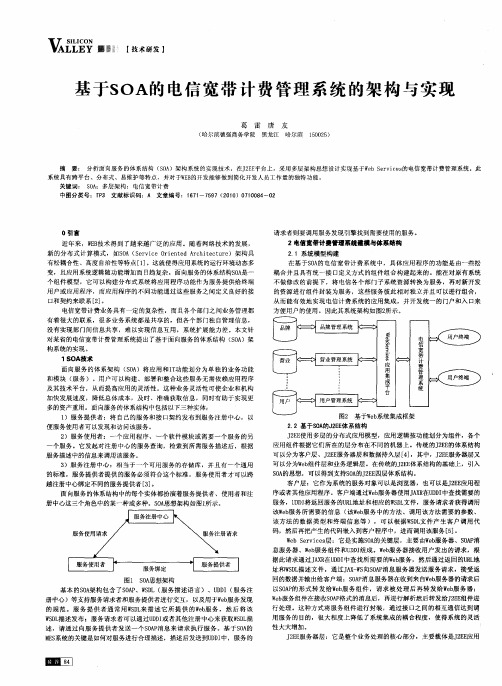
可 以分为 客户层 、JE 服 务器层和 数 据持久层 [] 2E 4 ,其 中,JE 服务器 层又 2E
可 以分为W b e 组件层 和业 务逻辑 层 。在传 统的J E体 系结构 的基 础上 ,引入 2E SA 思想 ,可 以得 到支 持SA 2 E O的 O 的J E 四层体 系结 构。
电信 宽带计 费业 务具 有一定 的复 杂性 ,而 且各 个部 门之 间业 务管理 都
有着 很大 的联 系 ,很多 业 务系统 都 是共享 的 ,但各 个 部 门独 自管理信 息 , 没有 实现 部 门间信 息共 享 ,难 以实现 信 息互 用 ,系统 扩展 能力 差 本文 针 对 某省 的 电信 宽带 计费管 理系统 提 出 了基 于面 向服务 的体 系结构 (O )架 SA 构系统 的实现 。 1 0A 术 S 技
用户 或应 用程 序 ,而应 用程 序 的不 同功 能通 过这 些服 务之 间定 义 良好 的接 口和 契约来 联系 [] 2。
不做 修 改的前 提 下,将 电信 各 个部 门子 系统 资源 转换 为服 务 ,再对 新 开发
的资源 进 行组 件封 装 为服 务,这 些 服务 彼此 相对 独立 并且 可 以进行 组合 , 从而 能有 效地 实现 电信 计 费系统 的 应用 集成 ,并 开发 统一 的 门户和 入 口来 方便用 户 的使用 。因此 其系 统架构 如 图2 示 。 所
系统 具有 跨平 台、分布式、易维护等特 点,并对于W B E 的开发能够做到简化开发人员工作 量的独特功能 。 关键 词: S A O ;多层架构; 电信宽带计 费 中图分类号 :T 3 文献标识码 :A 文章编号:1 7 —7 9 2 1 )0 1 0 4 0 P 6 1 5 7( 0 0 7 0 8 - 2
电信计费系统课程设计

电信计费系统课程设计一、课程目标知识目标:1. 理解电信计费系统的基本概念、原理及其在通信行业中的应用;2. 掌握电信计费系统的组成部分、功能及相互关系;3. 了解电信计费系统的业务流程、计费策略和收费方式;4. 掌握电信计费系统的安全性、可靠性和扩展性要求。
技能目标:1. 能够运用所学知识分析电信计费系统的实际案例,提出优化和改进方案;2. 学会使用相关软件工具设计简单的电信计费系统,实现基本计费功能;3. 能够编写简单的计费算法,对电信业务进行计费;4. 具备一定的团队协作和沟通能力,能够就电信计费系统设计与他人进行有效讨论。
情感态度价值观目标:1. 培养学生对电信计费系统的兴趣,激发他们探索通信行业发展的热情;2. 增强学生的信息安全意识,认识到电信计费系统在保护消费者权益方面的重要性;3. 培养学生严谨、务实的学习态度,提高他们分析问题和解决问题的能力;4. 培养学生的创新精神和团队协作精神,使他们具备一定的职业素养。
本课程目标旨在使学生在掌握电信计费系统相关知识的基础上,提高实际操作能力和综合素质,为未来从事通信行业工作打下坚实基础。
同时,注重培养学生的情感态度价值观,使他们在学习过程中形成正确的价值观和职业操守。
二、教学内容1. 电信计费系统概述- 电信计费系统的基本概念与原理- 电信计费系统的发展历程与现状- 电信计费系统在通信行业中的重要性2. 电信计费系统的组成与功能- 计费系统的基本组成部分- 各组成部分的功能与相互关系- 计费系统的主要业务流程3. 计费策略与收费方式- 常见计费策略及其特点- 计费参数的设置与调整- 收费方式的分类及实际应用4. 电信计费系统的安全性、可靠性与扩展性- 安全性要求及其保障措施- 可靠性要求及其实现方法- 扩展性要求及其设计原则5. 计费系统设计与实践- 计费算法的设计与实现- 计费系统软件工具的使用- 简单电信计费系统的设计与实现6. 电信计费系统案例分析与优化- 实际案例的介绍与分析- 现有计费系统的优缺点- 优化与改进方案的设计与讨论教学内容依据课程目标进行选择和组织,注重科学性和系统性。
- 1、下载文档前请自行甄别文档内容的完整性,平台不提供额外的编辑、内容补充、找答案等附加服务。
- 2、"仅部分预览"的文档,不可在线预览部分如存在完整性等问题,可反馈申请退款(可完整预览的文档不适用该条件!)。
- 3、如文档侵犯您的权益,请联系客服反馈,我们会尽快为您处理(人工客服工作时间:9:00-18:30)。
电信计费管理系统设计与实现设计电信计费管理系统设计与实现作者姓名:XXXX 专业班级:2005070302 指导教师:潘斌摘要随着我国电信业的迅猛发展,各项业务量快速增长,新的业务种类和新的服务形式不断推出,电信计费管理系统的重要性日益突出。
本文通过对电信计费的基本原理、实现流程等进行研究分析,完成了计费管理系统的总体规划、分析、设计、实现以及运行调试和评价,其中使用管理信息系统结构化开发方法完成系统分析与设计工作,使用UML建模的方法完成了系统的实现工作。
该系统基于B/S模式,以Oracle为后台数据库,用MyEclipse 6.5、Tomcat 6.0、PowerDesigner 12等工具进行开发。
系统后台数据库中通过存储过程和JOB定时器实时地对话单数据进行统计,并在前台使用JSP和AJAX技术实时展现统计数据。
该系统具有很好的实用性,可帮助相应工作人员方便地完成各种话单统计工作,提高工作效率。
关键词:计费管理系统;系统分析与设计;结构化方法;UML建模Design and Implementation of Telecom Billing Management SystemAbstract: In recent years, with the rapid development of China's telecom, the rapid growth of new business volume, types and new services. In order to make these continuously develop business to better development, the importance of the management system of telecommunication billing increasingly prominent. This thesis researches and analyses the fundamental principle, implement of bill system of telecom business. Its system planning, analysis, design, implementation, operation and evaluation have accomplished by the structured development method of management of information system, and UML modeling method. This system is based on B/S model, selecting MyEclipse6.5 Tomcat6.0, JDK6.7 and PowerDesigner12 as development tools with Oracle 10g for database of it. In front of the system use AJAX and JSP to show data, in the system of data stored in the backend database using real-time process and JOB timer for statistics bill data, so that relevant personnel can get real-time data. The system has good practicability; the system can make a convenience of the statistics of kinds of fee list for the telecom operators meanwhile can make a high efficiency for telecom staff.Keywords: Billing Management System; System Analysis and Design;Structured Method; UML Modeling.目录第1章前言 (1)第2章项目概述 (2)2.1. 项目开发背景 (2)2.2. 项目开发目的 (2)2.3. 项目开发方法 (3)第3章系统总体规划 (4)3.1. 系统初步调查 (4)3.2. 可行性分析 (4)3.3. 组织机构调查 (5)3.4. 系统逻辑业务规划 (6)3.5. 系统数据类规划 (6)3.6. 系统开发计划 (7)4.1. 系统详细调查 (9)4.2. 需求分析 (11)4.2.1. 系统面向的用户 (11)4.2.2. 系统管理员需求 (12)4.2.3. 资料管理员需求 (12)4.2.4. 查询统计管理员需求 (14)4.2.5. 告警处理员需求 (16)4.3. 业务流程分析 (16)4.4. 数据流程分析 (20)4.5. 数据字典 (24)4.6. 系统逻辑模型 (26)第5章系统设计 (27)5.1. 模块结构设计 (27)5.1.1. 系统管理模块结构 (27)5.1.2. 资料管理模块结构 (28)5.1.3. 查询统计管理模块结构 (28)5.1.4. 监控告警管理模块结构 (28)5.2. 代码设计 (30)5.3. 数据库设计 (31)5.3.1. 概念模型设计 (31)5.3.2. 逻辑模型设计 (34)5.3.3. 物理模型设计 (35)5.4. 人机界面设计 (39)5.4.1. 登录界面 (39)5.4.2. 系统管理主界面 (39)5.4.3. 资料管理主界面 (40)5.4.4. 查询统计管理主界面 (41)5.4.5. 监控告警管理主界面 (42)6.1. 计算机逻辑配置 (43)6.1.1. 计算机局域网络配置 (43)6.1.2. 计算机广域网络配置 (43)6.2. 系统实施准备 (44)6.3. 项目开发环境及工具介绍 (45)6.3.1. MVC模式简介 (45)6.3.2. Struts 2和Hibernate3.0技术框架简介 (45)6.4. 程序设计 (46)6.4.1. 程序设计方法及风格 (46)6.4.2. 系统管理模块程序设计 (47)6.4.3. 资料管理模块程序设计 (49)6.4.4. 查询统计管理模块程序设计 (52)6.4.5. 监控告警管理程序设计 (54)6.5. 系统测试与调试 (56)6.5.1. 功能测试 (56)6.5.2. 性能测试 (56)6.5.3. 系统调试 (56)第7章系统运行管理与评价 (57)7.1. 系统的运行管理 (57)7.2. 系统的评价 (58)7.2.1. 经济指标评价 (58)7.2.2.性能指标评价 (58)7.2.3. 管理指标评价 (58)结论 (59)致谢 (60)参考文献 (61)附录 (62)第1章前言如今,各电信运营商已越来越强烈地注意到这样一个现实:即基于分组的下一代网络只是整个服务提交体系中的一个不可或缺组成部分,这类网络虽然能够用来提交各种基于分组的新型增值业务,但却无法为运营商业务的发展提供直接的融资和收益。
只有将可盈利的增值业务推向市场才是决定运营商成功与否的关键。
为了最大限度地实现投资回报,运营商需要不分服务类型地向其所有用户提供一切所需的服务,并将其主要精力放在用户真正期望服务的开发和管理方面。
一个好的计费解决方案则是实现上述目标的先决条件,比如实时计费解决方案等。
实时的计费解决方案不仅可使运营商在任何基于分组的网络上向不同类型的用户提交一切服务,并通过开发新的收益来源来增加平均每户每月收入值,还能使运营商按照用户的切实需求迅速地将增值服务推向市场。
其次,它能够有效地帮助运营商弥补在数据业务预付费方面存在的技术差距,并以较低的成本真正实现预付费与后付费的融合。
最后,它还能促使运营商将所需的基础设施及时安排到位,并着手就第三方提供的内容展开交易并顺利实现收益结算。
但是,好的实时计费方案也需要有配套的计费管理系统进行数据统计和异常数据监控,才能完美发挥其作用。
总之,电信计费管理系统已不再是被动的后台系统,其作为整个电信行业的核心竞争力所在的地位日益巩固,已经成为整个电信系统的灵魂。
它能有效地提供服务,降低运营成本,提高运营效率。
无论是运营商、内容提供商还是各分销商必须给予它足够的重视,才能在群雄逐鹿中占居有利地位。
第2章项目概述2.1. 项目开发背景从电信运营商来看,电信计费远不是通话时长乘以费率这么一个简单算式就能解决的。
以固话为例,要生成账单,首先交换机要将主叫、被叫、通话时长等实时记录,然后系统把采集到的交换机记录经过预处理、过滤、划价、累计求和,才能形成最后的用户账单。
电信全程全网的特性,使得用户在使用电信业务过程中要涉及多个环节。
传统的计费系统只是一个数据的处理系统,如果由于时钟同步、信令传送等问题,影响到所采集数据的准确性,那么计费的结果就会出现偏差。
因此,建立配套的计费管理系统的必要性就突现出来了。
由于历史原因,交换机的种类繁多,采集方式也不完全一样以及计费软件的版本比较复杂,都会给计费管理系统的实施造成困难。
不过,尽管有着重重困难,运营商依然不断努力,逐步实施。
比如中国移动的用户现在就可以通过营业厅账单打印、网上查询、1860客服热线等多种渠道得到自己消费的详细情况统计。
计费管理的价值不仅体现在为客户服务,提高服务质量上面。
对于运营商来说,实现计费管理可以帮助运营商更好地了解运营状况,比如可以发现高额欠费,及时进行预警等。
所以,计费系统管理的重要性更加突出。
在这样的背景下,根据客户实际境况,我们提出了电信计费管理系统开发需求。
在系统开发完成以后,本系统会在电信运营商某地区计费中心的营运环境中部署运行。
2.2. 项目开发目的在电信运营系统中,电信计费系统是主要的支撑系统,占有重要地位。
计费系统有效、安全地运行,在很大程度上影响着电信运营系统本身的运行效率和信誉。
计费系统历来都是电信运营和管理部门重点建设和发展的系统之一。
本项目开发的主要目的有以下几点:1.为用户提供准确的、快速的、展示方式多样的、实时的、方便的话单统计数据,以使用户可以在此基础上进行其他的工作;2.在后台数据库中使用存储过程和JOB定时器实现数据的实时统计,以便提高前台再次统计数据的效率;3.使用B/S应用模式,以WEB方式给用户展现所需要的统计数据,可以提供表格、饼图和柱图来展现统计结果;4.使用J2EE技术体系开发本项目系统,结合一些先进技术(AJAX、DWR、SiteMesh等),完成扩展性、可移植性、稳定性较强的实用系统;5.对个人来说,将所学的系统开发专业技术知识和电信计费的业务知识结合起来,完成有实际意义的实践工作。
